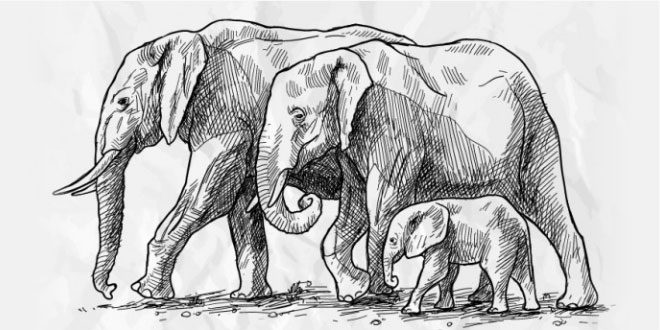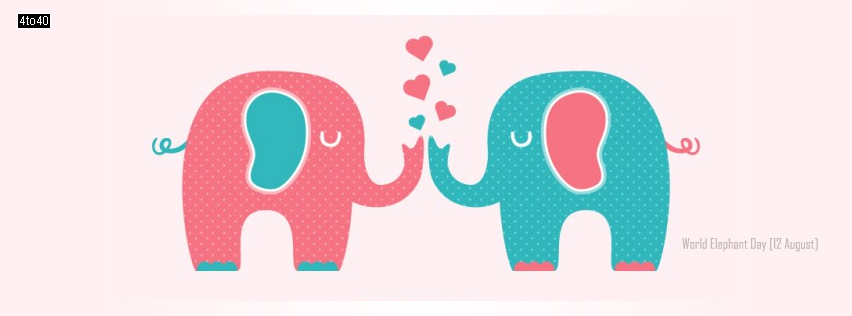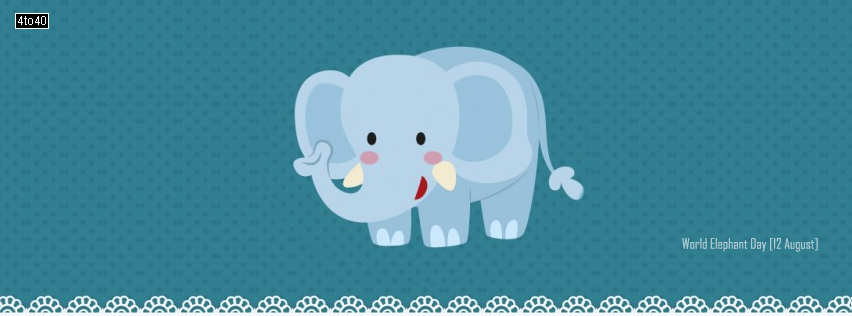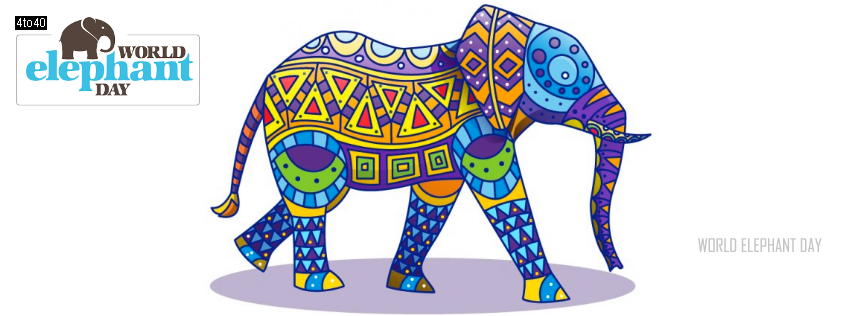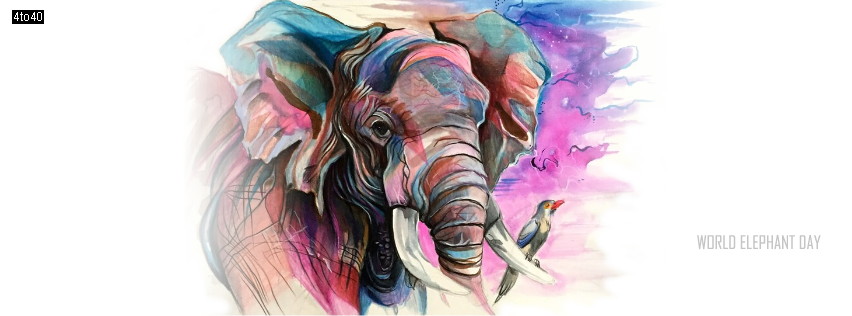Despite elephant-headed Ganesha being widely worshiped across India, at least 100 elephants die every year in the country, with many poached for ivory and many more captured and sold to traffickers.
Incidents of cruelty against elephants are many. The most recent being the rescue of a “begging elephant” from Uttar Pradesh after five decades of slavery, and also the seizure of 536 kg ivory in Kerala.
Years of exploitation has made the Asian elephant an endangered species, while their African counterparts too have become vulnerable.
On World Elephant Day on August 12, the torture faced by this majestic animal that is behind many a joy ride, circus performance and even temple blessing calls for more sensitivity towards treatment of the elephant and enforcement of established norms, say experts.
“It takes about six months of consistent torture to break an elephant calf’s strength and courage in order to domesticate it — thereby making it fit for sale,” Kartick Satyanarayan, co-founder of animal conservation organisation Wildlife SOS, told media.
For a juvenile elephant the degree of the torture is three times more in order to “break it”.
After this “orientation” — which involves starvation, piercing of the ears with hot iron rods and pulling a rope through the pierced holes to restrict its movement, these animals are sold to circuses, temples, the timber-lifting trade or safaris for further training and service.
This is where it faces more beatings and undergoes painful training where bullhooks or elephant goads are used to jab it near the neck and head, in order to control it.
“Many owners who claim that they care for their animals do not tell the whole truth. They cannot manage elephants without using an ankush or a bullhook, which is extremely cruel and is illegal to use,” Kartick says, referring to the case of Rambo Circus in Pune, where four elephants, including one which was blind, were rescued in June. However, they were returned to the circus due to legal loopholes.
“Several states in North America have prevented the performance of elephants by banning the use of bullhooks on the grounds of cruelty. Circuses cannot train elephants without these cruel tools of torture,” he added.
According to elephant biologists, without the methods of torture it may take up to six years for a calf to become submissive.
“They are being trafficked and poached from everywhere. Be it West Bengal, Karnataka, Uttar Pradesh, Uttarakhand, Odisha, Andhra Pradesh or North-east,” Shekhar Kumar Niraj, Head TRAFFIC, WWF-India, told media.
He estimates the annual figure of elephant poaching to be around 30.
As per the Union Environment Ministry, there are over 30,000 elephants across 16 elephant states in India. About 4,000 are in captivity.
In Southeast Asia, nearly 40,000 Asian elephants are distributed across 13 countries.
As per a 2010 report by Asian Nature Conservation Foundation (ANCF) most of the elephants in India are illegally acquired. The experts often find forged paperwork as the easiest way to legitimise the trade.
“Kerala, like Bihar, sources its elephants mainly from Assam through Bihar’s Sonepur mela,” the report stated. Kerala has the maximum number of captive elephants.
It is estimated that at least 800 elephants were sold in Bihar, Kerala, Tamil Nadu and Rajasthan between 1997 and 2002.
Rajasthan’s Amber area in Jaipur is also considered a hub of elephant trafficking.
The trade goes on despite existing laws such as Prevention of Cruelty to Animals Act 1960; the Performing Animals (Registration) Rules 2001; The Indian Wildlife (Protection) Act 1972; and Recognition of Zoo Rules, 2009.
Animal experts say that by the time elephants are rescued, they develop psychological disorders and are unfit to be released in the wild due to the extensive damage done to them. One such common disorder is swaying the trunk.
“Sometimes by the time we reach the elephant after overcoming legal hurdles, it’s too late,” Kartick said.
With over 22 rescued elephants, Wildlife SOS runs two elephant conservation and care centres in Mathura, Uttar Pradesh, and in Haryana.
In India, less than 100 elephant corridors remain in the wild, with many dysfunctional and all shrinking, restricting the movement of elephants — providing a perfect ground to hunt them, say experts.
What Is the Theme of World Elephant Day?
- 2024: Personifying prehistoric beauty, theological relevance, and environmental importance
- 2023: Ending the Illegal Wildlife Trade
History:
The World Elephant Day was co-founded on August 12, 2012, by Patricia Sims from Canada and the Elephant Reintroduction Foundation of Thailand, an initiative of HM Queen Sirikit of Thailand.
- Patricia Sims has remained at the forefront of World Elephant Day’s leadership since its inception.
- Over the years, this initiative has established partnerships with 100 elephant conservation organizations worldwide and has garnered the support of countless individuals across the globe.
- The active participation of millions of people in acknowledging World Elephant Day showcases the widespread love for elephants and the collective desire to contribute to their well-being.
World Elephant Society:
- In November 2015, the World Elephant Society was established as a nonprofit tax-exempt 501(c)(3) public charitable organization.
- Its primary purpose is to provide support for the annual World Elephant Day campaign.
- Patricia Sims serves as its President and Executive Director.
- The organization’s vision is to continually expand its educational outreach each year, making it a central and integral part of its mission.
Threats that Elephants basically face:
- Poaching
- Human-elephant conflict.
- Mistreatment in captivity.
- Do not ride on an elephant.
Above mentioned threats are faced by African and Asian Elephants
Solutions for the threats are:
- Together work towards better protection for wild animals.
- Improve enforcement policies to prevent illegal poaching.
- Improve the illegal trade of ivory.
- Conserve the habitats of elephants.
- Provide better treatment for captive elephants
- When it is appropriate then reintroduces captive elephants into the natural habitat.
- Protect sanctuaries is one of the goals of several elephant conservation organisations and focuses around the world.
Significance:
This day is significant as it raises awareness about the plight of elephants and the need to protect them. Elephants are facing several threats, including habitat loss, poaching, and conflict with humans. Poaching is the biggest threat to elephants, and it is estimated that over 30,000 elephants are killed each year for their ivory tusks.
World Elephant Day is a day to celebrate the beauty and intelligence of elephants and to raise awareness of the challenges they face. It is also a day to call for action to protect elephants and ensure their survival.
Significance of World Elephant Day
- It raises awareness about the plight of elephants. World Elephant Day helps to raise awareness about the threats that elephants face, such as habitat loss, poaching, and conflict with humans. This awareness can help to encourage people to take action to protect elephants.
- It encourages people to take action to protect elephants. World Elephant Day encourages people to take action to protect elephants, such as donating to elephant conservation organizations, speaking out against the ivory trade, and choosing elephant-friendly products. These actions can help to make a difference for elephants and help to ensure their survival.
- It unites people in the fight to protect elephants. World Elephant Day unites people from all over the world in the fight to protect elephants. This unity can help to amplify the voice of elephant conservationists and can help to put pressure on governments and organizations to take action to protect elephants.
- It celebrates the beauty and intelligence of elephants. World Elephant Day celebrates the beauty and intelligence of elephants. This celebration can help to remind people of the importance of elephants and the need to protect them.
It is a significant day that raises awareness about the plight of elephants and the need to protect them. By taking part in any of the activities listed above, you can make a difference for elephants and help to ensure their survival.
Why Elephants are important?
Elephants are magnificent creatures that play a crucial role as gardeners of forests and savannas. They have a unique ability to help plants germinate by passing seeds through their digestive system. Many plants rely on elephants to facilitate their growth in this way. Additionally, elephants hold great allure for tourists worldwide, attracting millions of travelers who contribute to the tourism industry in the countries where these majestic animals reside. This not only generates income but also creates job opportunities within the tourism sector.
Why they are threatened by illegal trade?
The illegal poaching of elephants for their ivory remains a significant and troubling issue.
- In recent years, experts have estimated that a staggering number of around 100,000 elephants were killed between 2010 and 2012 alone.
- The demand for ivory tusks drives this poaching, with ivory being used for various products ranging from jewelry like bangles to religious artifacts and intricate carvings.
- The trade and sale of high-value ivory items have become major drivers behind the unlawful killing of elephants.
Regarding regulations, both African and Asian elephants are listed under CITES Appendix I, which indicates the highest level of protection. However, there are exceptions for certain populations of African elephants from Botswana, Namibia, South Africa, and Zimbabwe, which are listed in Appendix II. As per these regulations, international commercial trade in raw ivory is strictly prohibited. The aim is to curb the illegal ivory trade and protect these magnificent creatures from further harm.
Ivory Trade:
In 1989, the Convention on International Trade in Endangered Species (CITES) imposed a worldwide ban on the ivory trade. However, despite this ban, the legal ivory trade persists in several countries, such as Japan, and the illegal black market trade remains active and profitable.
- Tusks are present in both male and female African elephants, whereas, in Asian elephants, only males have tusks. Interestingly, due to the impact of poaching, some female African elephants are now being born without tusks, a genetic mutation that has arisen as a response to the threat.
- The year 2013 marked a significant milestone, as it saw the highest quantity of confiscated ivory in the past 25 years.
- In May 2016, Kenya demonstrated its strong stance against the illegal ivory trade by conducting a historic event where it publicly burned 105 tons of ivory. This act represented the largest ivory burn in history and conveyed Kenya’s commitment to combating the illegal trade and protecting elephants.
 Kids Portal For Parents India Kids Network
Kids Portal For Parents India Kids Network
